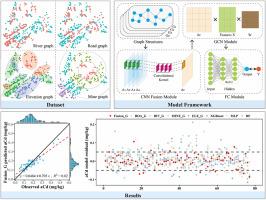Multigraph fusion neural network for predicting available cadmium levels in farmland soils
IF 7.3
2区 环境科学与生态学
Q1 ENVIRONMENTAL SCIENCES
引用次数: 0
Abstract
Cadmium (Cd), a primary heavy metal pollutant in farmland soils, poses a significant threat to soil ecosystems and human health, developing accurate machine learning models to predict soil available Cd concentration is crucial for formulating effective remediation strategies. However, most existing models rely on the simple aggregation of multiple environmental and geographical variables to predict soil available Cd concentration, often neglecting the complex interrelationships among these variables and the spatial effects of geographic factors. In this work, a novel multigraph fusion neural network model based on the spatial relationships between sampling points and various geographic factors (elevation, mine, roads, and rivers) is proposed. By integrating multiple spatial relationship graphs, the model effectively captures the spatial effects of geographic factors on the farmland soil environment. The results demonstrate that the multigraph fusion model significantly outperforms the other models in predicting soil available Cd concentration, achieving R2 value of 0.82, RMSE value of 0.0338 mg kg−1, and MAE value of 0.0249 mg kg−1. Compared with the single-graph models and baseline models, the multigraph fusion model provides lower residual distribution range and more stable prediction performance. These findings validate the feasibility of incorporating the spatial effects of geographic factors to increase the prediction performance of soil available Cd concentration models and offer valuable analysis tools into the environmental drivers underlying the spatial heterogeneity in heavy metal contamination in farmland soils.

多图融合神经网络预测农田土壤有效镉含量
镉(Cd)是农田土壤中的主要重金属污染物,对土壤生态系统和人类健康构成重大威胁,开发准确的机器学习模型来预测土壤有效镉浓度对于制定有效的修复策略至关重要。然而,现有的模型大多依赖于多个环境和地理变量的简单集合来预测土壤有效镉浓度,往往忽略了这些变量之间复杂的相互关系和地理因子的空间效应。在这项工作中,提出了一种新的基于采样点与各种地理因素(海拔、矿山、道路和河流)之间空间关系的多图融合神经网络模型。该模型通过对多个空间关系图的整合,有效捕捉了地理因子对农田土壤环境的空间效应。结果表明,多图融合模型预测土壤有效镉浓度的R2值为0.82,RMSE值为0.0338 mg·kg-1, MAE值为0.0249 mg·kg-1,显著优于其他模型。与单图模型和基线模型相比,多图融合模型残差分布范围更小,预测性能更稳定。这些研究结果验证了将地理因子的空间效应纳入土壤有效镉浓度模型的可行性,并为农田土壤重金属污染空间异质性的环境驱动因素提供了有价值的分析工具。
本文章由计算机程序翻译,如有差异,请以英文原文为准。
求助全文
约1分钟内获得全文
求助全文
来源期刊

Environmental Pollution
环境科学-环境科学
CiteScore
16.00
自引率
6.70%
发文量
2082
审稿时长
2.9 months
期刊介绍:
Environmental Pollution is an international peer-reviewed journal that publishes high-quality research papers and review articles covering all aspects of environmental pollution and its impacts on ecosystems and human health.
Subject areas include, but are not limited to:
• Sources and occurrences of pollutants that are clearly defined and measured in environmental compartments, food and food-related items, and human bodies;
• Interlinks between contaminant exposure and biological, ecological, and human health effects, including those of climate change;
• Contaminants of emerging concerns (including but not limited to antibiotic resistant microorganisms or genes, microplastics/nanoplastics, electronic wastes, light, and noise) and/or their biological, ecological, or human health effects;
• Laboratory and field studies on the remediation/mitigation of environmental pollution via new techniques and with clear links to biological, ecological, or human health effects;
• Modeling of pollution processes, patterns, or trends that is of clear environmental and/or human health interest;
• New techniques that measure and examine environmental occurrences, transport, behavior, and effects of pollutants within the environment or the laboratory, provided that they can be clearly used to address problems within regional or global environmental compartments.
 求助内容:
求助内容: 应助结果提醒方式:
应助结果提醒方式:


